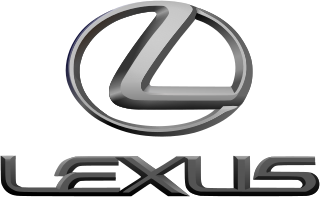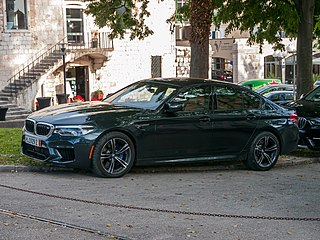Related Research Articles

Lexus is the luxury vehicle division of the Japanese automaker Toyota Motor Corporation. The Lexus brand is marketed in more than 90 countries and territories worldwide and is Japan's largest-selling make of premium cars. It has ranked among the 10 largest Japanese global brands in market value. Lexus is headquartered in Nagoya, Japan. Operational centers are located in Brussels, Belgium, and Plano, Texas, United States.

A luxury car is a car that provides above-average to high-end levels of comfort, features, and equipment. Often more expensive materials and surface finishes are used, and buyers expect better build quality. The usually higher pricing and more upscale appearance is often associated with higher social status of the users, compared to low and mid-market segment cars.

Infiniti is the luxury vehicle division of the Japanese automaker Nissan. Infiniti officially started selling vehicles on November 8, 1989, in North America. The marketing network for Infiniti-branded vehicles included dealers in over 50 countries in the 2010s. As of 2020, there were 25 markets served by new car dealers. The main markets are North America, China, and the Middle East.

The Volkswagen Phaeton is a full-size sedan/saloon manufactured by the German automobile manufacturer Volkswagen, described by Volkswagen as their "premium class" vehicle. Introduced at the 2002 Geneva Motor Show, the Phaeton was marketed worldwide. Sales in North America ended in 2006 and global sales ended in 2016.

Maybach is a German luxury car brand owned by and a part of Mercedes-Benz AG. The original company was founded in 1909 by Wilhelm Maybach and his son Karl Maybach, originally as a subsidiary of Luftschiffbau Zeppelin GmbH, and it was known as Luftfahrzeug-Motorenbau GmbH until 1999.

The Lexus LS is a full-size luxury sedan serving as the flagship model of Lexus, the luxury division of Toyota. For the first four generations, all LS models featured V8 engines and were predominantly rear-wheel-drive. In the fourth generation, Lexus offered all-wheel-drive, hybrid, and long-wheelbase variants. The fifth generation changed to using a V6 engine with no V8 option, and only one length was offered.
The automotive industry in India is the fourth-largest by production in the world as per 2022 statistics. As of 2023, India is the 3rd largest automobile market in the world in terms of sales. In 2022, India became the fourth largest country in the world by the valuation of its automotive industry.

Executive car is a British term for a large car which is equivalent to the European E-segment and American full-size classifications. Executive cars are larger than compact executive cars, and smaller than luxury saloons / full-size luxury sedans.

European delivery programs are arrangements that continental European automobile manufacturers make with their dealerships throughout the world, to attract consumers who will combine the purchase of a European-made automobile with a trip to Europe. These are typically aimed at the North American market, which constitutes the most profitable market for Audi, Mercedes-Benz, BMW, Volvo and Porsche.
In the United States automotive industry, the term Big Three is used for the country's three largest motor vehicle manufacturers, especially indicating companies that sell under multiple brand names.

The automotive industry in Chinese mainland has been the largest in the world measured by automobile unit production since 2008. As of 2024, China is also the world's largest automobile market both in terms of sales and ownership.
Beijing International Automotive Exhibition, Beijing Motor Show or Auto China is an auto show held biennially in Beijing, China since 1990. China is currently the largest auto market in the world.

Mercedes-Benz India Pvt Ltd is a wholly owned subsidiary of the German Mercedes-Benz Group founded in 1994, with headquarters in Pune, Maharashtra, India.

The D-segment is the 4th category of the European segments for passenger cars, and is described as "large cars".

The F-segment is the 6th category and largest of the European segments for passenger cars, and always belongs to "luxury cars".

The automotive industry in Germany is one of the largest employers in the world, with a labor force of over 857,336 (2016) working in the industry.

BMW India is the Indian subsidiary of German car manufacturer BMW. It started operations in January 2007 with a wide range of its activities, includeing a manufacturing plant in Chennai, a parts warehouse in Mumbai, a training centre in Gurgaon NCR, and development the of a dealer organisation across major metropolitan centres of the country.
Shenzhen BYD New Energy Co., Ltd., trading as Denza, is an automobile manufacturing company headquartered in Shenzhen, China, specialising in luxury electric cars and a joint venture between BYD Auto Industry and the Mercedes-Benz Group. Founded in May 2010, in late 2014 the company introduced its first model, the Denza EV. The car was initially put on sale in selected Chinese cities only. In late 2021, Denza underwent a restructuring as Mercedes-Benz reduced its share to 10%, while BYD held the rest.
Jardine Motors Group, is a multi-national operator of franchised motorcar dealerships in the United Kingdom with international outlets in Hong Kong, Macau and China. Jardine Motors Group market their vehicles under a series of brands worldwide including Zung Fu, Lancaster and Scotthall, and the worldwide group net profit, for the year ended 30 April 2012, was US$61 Million, based on revenue of US$5.128 Billion.

A coupe SUV is a type of sport utility vehicle with a sloping rear roofline similar to those of fastbacks or Kammbacks. The sloping roofline is adopted to offer a styling advantage compared to its standard SUV counterpart, which helps increase profit margins as manufacturers are able to raise the price by marketing it as a more premium model. Since all coupe SUVs ever produced are of the crossover variety, coupe SUVs may also be called "coupe crossovers" or "coupe crossover SUVs".
References
- 1 2 Diaz Ruiz, Carlos; Cruz, Angela Gracia B. (2023-01-01). "Unconventional luxury brand collaborations: a new form of luxury consumption among young adults in China". International Marketing Review. 40 (7): 1–21. doi: 10.1108/IMR-04-2022-0099 . ISSN 0265-1335.
- ↑ "China bans television ads for bling" . Retrieved February 15, 2013.
- ↑ McKinsey (2019). "The Chinese luxury consumer". McKinsey Quarterly.
- ↑ D'Arpizio, Claudia; Levato, Federica; Prete, Filippo; Gault, Constance; de Montgolfier, Joëlle (2021-01-14). "The Future of Luxury: Bouncing Back from Covid-19". Bain & Company. Retrieved 2023-05-29.
- ↑ Keywords to learn China, The Korea IT Times , May 28, 2010.
- ↑ China still has an appetite for luxury goods
- 1 2 Qu Yunxu (February 26, 2013). "China's Frills and Posh Market Springs a Leak: Wealthy Chinese consumers continue to drive global demand for luxury goods, but the engine is losing steam". Caixin. Retrieved February 26, 2013.
- ↑ Global Luxury Survey: China, TIME .
- ↑ China Luxury Market study 2010, Bain & Company.
- ↑ "Catering to the Chinese Shopper’s Grand Tour" article by Nicola Clark in The New York Times February 3, 2014
- 1 2 3 Simpson, Tim (2023). Betting on Macau: Casino Capitalism and China's Consumer Revolution. Globalization and Community series. Minneapolis: University of Minnesota Press. ISBN 978-1-5179-0031-1.
- ↑ Audi’s Two-Decade China Dominance Threatened by BMW, Mercedes, April 21, 2010.
- 1 2 3 ANDREW JACOBS; ADAM CENTURY (November 14, 2011). "In China, Car Brands Evoke an Unexpected Set of Stereotypes". The New York Times.
- ↑ "Still racing ahead". The Economist. 9 March 2013.
- ↑ Rich Chinese fueling luxury car market growth, People's Daily Online , April 29, 2010.
- ↑ Keith Bradsher (April 21, 2013). "Chinese Auto Buyers Grow Hungry for Larger Cars". The New York Times. Retrieved April 22, 2013.
- ↑ Raphael Minder (April 26, 2013). "Watchmakers Find Gold Rush in China Is Slowing Down". The New York Times. Retrieved April 27, 2013.
- ↑ Joe Weisenthal (May 13, 2013). "Chinese Gold Jewelry Sales Went Ballistic In April". Business Insider. Retrieved May 13, 2013.